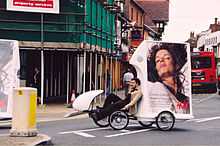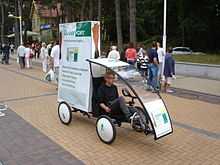Mobile billboard





A mobile billboard is a device used for advertising on the side of a truck or trailer that is typically mobile. Mobile billboards are a form of out-of-home advertising (OOH); radio, static billboards, and mall/airport advertising fall into this same category. Using a mobile billboard for advertising is an advertising niche called mobile outdoor advertising.
Description
Most mobile billboards are dedicated, customized trucks with large, but narrow, bodies for posting the advertisements. Some of these dedicated units offer features such as external sound systems, illumination, and hot/cold boxes for product sampling. This type of mobile billboard is the most popular among vendors, and the most capable in terms of gaining exposure and quick deployment. An innovative development of mobile billboards is dynamic advertising trailers called "SkyBoard" to hoist large format vinyl banners up to 4,000 square feet (370 m2).
Another trend is to use smaller but more distinctive looking mini mobile billboards, often based on the Daihatsu Midget from Japan, as it is an unusual looking vehicle in Europe and the US. These one-seater vehicles have a very short wheelbase; they can be parked sideways so the large advertising panels on the side are facing the traffic flow.
Some mobile billboards are installed on trucks and trailers that are in service delivering goods. This form of mobile billboards can be less expensive than dedicated trucks, but may also make fewer impressions because the trucks spend more time at loading docks.
Box-type trucks with glass panels enclosing the cargo space can be turned into a mobile 3D display case. Many companies use these trucks for parades, product launches, furniture displays, and general rapid-awareness creation. Almost anything can be placed inside of the boxes for display.
For micromarketing campaigns, small engine scooters are used to pull a tall and narrow signage trailer. This form has become a very effective intercity advertising method for Atlanta, Georgia.
Installation
Advertisements are installed by applying large vinyl sheets as decals, or by fastening a large sheet of vinyl to the sides of the truck or trailer using specialized aluminum frames. The advertisements can also be painted directly onto the side of the truck or trailer.
With the new mobile digital display billboards (Traffic AdBoards), changing ad campaigns is as easy as either loading the ads via USB or over the Internet.
Printing technology
Printing technology has improved to the point where outdoor mobile advertising has become an option that may be less expensive than traditional billboard advertising.
Effectiveness
Industry analysts, researchers and trade representatives have researched the effectiveness of mobile billboards. Outdoor Advertising Magazine said that outdoor mobile media billboards have a 97% recall rate, and 96% of survey respondents thought mobile advertising is more effective than traditional outdoor advertising. 3M and the American Trucking Association noted 91% of the target noticed the text and graphics on truck advertising, and the Traffic Audit Bureau noted that on local routes monthly impressions ranged from one to four millions hits. Product Acceptance and Research said 94% of respondents recalled seeing the Mobile Billboard, with 80% recalling the specific advertisement; the billboards resulted in a sales increase of 107%.
Legality
Some municipalities have strict laws against mobile advertisements. Mobile billboards have been accused of congesting already congested streets, since they are deployed in areas with high population density. In such areas, non-motorized but mobile advertisements (i.e. adbikes and billboard bicycles) can often be used as a substitute. New designs often include smaller lighter trucks that can keep up with stop-and-go traffic and maneuver through downtown city blocks without causing as much congestion. These mobile billboard trucks have been welcomed more by municipalities over the larger trucks.
In the US, mobile advertising falls under the First Amendment to the United States Constitution. The US Supreme Court has issued rulings that protect "commercial speech" as well. Hence, it is difficult for any jurisdiction to limit such advertising beyond public safety issues. Since most complaints regarding mobile advertising relate to oversized trucks with loudspeakers, the bigger companies are more likely to have lawyers on retainer who can remind the authorities of US Constitutional protection of free speech and commerce. However, content-neutral regulations of speech with a legitimate government interest are subject to a more deferential standard of review. Ordinances banning mobile billboards on traffic and public safety grounds, regardless of message and without singling out commercial advertisement, have been largely upheld as legitimately and reasonably regulating the form, and not content, of speech.
In Norway, the use of wrap advertising on buses was prohibited by the road authorities. The reason behind the ban was that in an emergency, the windows might need to serve as an emergency exit and that the advertising would make the window harder to break with the emergency hammer. Gaia Trafikk argued against the ban, pointing out that their tests showed that the thin wrap had no impact on the breakability of the window, but did remove the advertising which covered the windows.[1]
Other forms
There are many other forms of outdoor mobile advertising, which are considered mobile billboards by some advertising professionals.
One such form is called wrap advertising, which differs from mobile billboards because wrap advertisements typically envelop an entire vehicle, typically a car or small truck, while mobile billboards are large flat surfaces like traditional billboards.
Other mobile advertising formats include bicycles, airplane banner towing, blimps, and mobile billboards on water towed by boats.
Companies have developed a new form of mobile billboard called digital or video mobile advertising. The principle is the same as that of traditional mobile billboards except that a digital or video mobile advertising "billboard" is an actual video screen, which can display mini-movie commercials.
See also
| Wikimedia Commons has media related to Advertising vehicles. |
- Billboard
- Bus advertising
- Driven media
- Out-of-home advertising
- Wrap advertising
- Live billboards
References
- ↑ Livsfarlig reklame ("Life-threatening advertising") Dagbladet, July 5, 2001, retrieved April 17, 2007